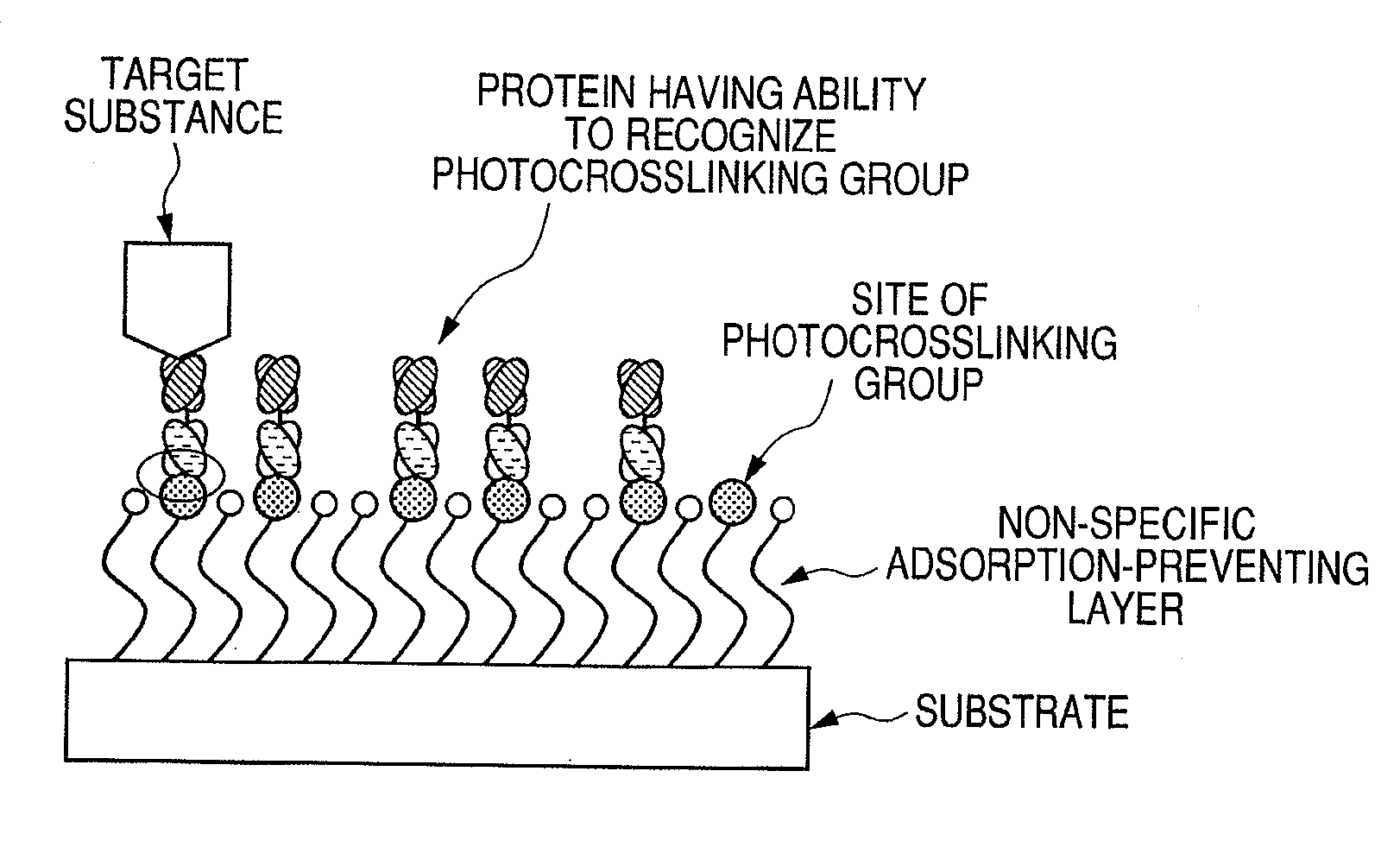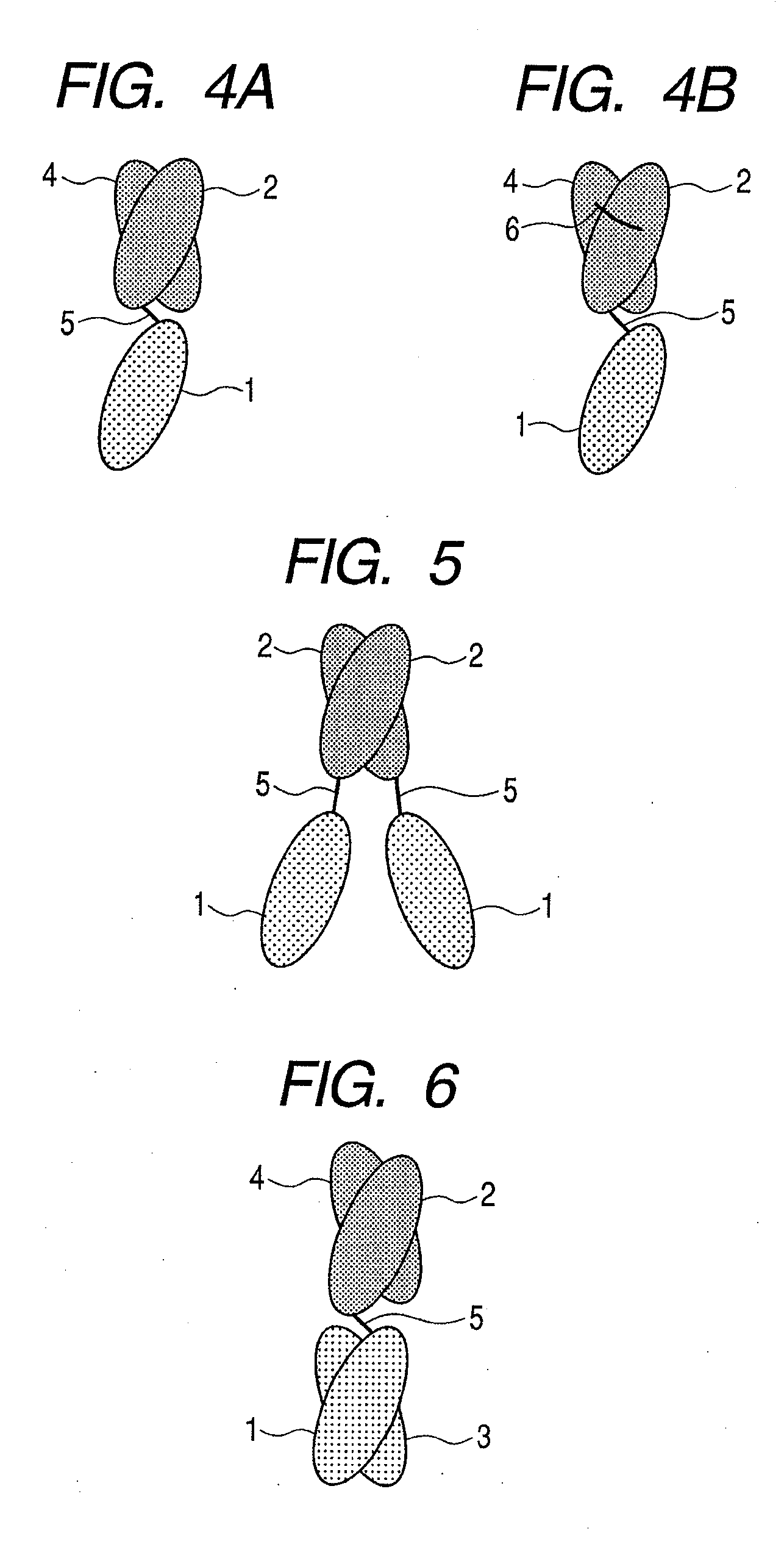Protein, method for immobilizing protein, structure, biosensor, nucleic acid, vector and kit for detecting target substance
a technology of immobilizing protein and target substance, which is applied in the field of protein, method of immobilizing protein, biosensor, nucleic acid, vector and kit for detecting target substance, can solve the problems of adversely affecting the productivity of a certain protein, limited application of this protein in a biosensor, and difficult homogeneous immobilization of plural proteins onto a substrate by the same immobilization method
- Summary
- Abstract
- Description
- Claims
- Application Information
AI Technical Summary
Problems solved by technology
Method used
Image
Examples
example 1
Mouse Immunization with Immunogen
[0165]To acquire an anti-photocrosslinking group antibody of the present invention, a mouse was immunized six times with a 4-(1-Azi-2,2,2-trifluoroethyl)benzoic acid-KHL conjugate (manufactured by Yanaihara Institute Inc.) as an immunogen. The immunogen solution before immunization was handled within the place surrounded by yellow curtains.
[0166]The first immunization was performed by the following procedures; first, 0.7 ml of Freund's complete adjuvant (manufactured by CALBIOCHEM, Code No. 344289) was added to 0.7 ml of a 2 mg / ml immunogen solution (1.4 mg of immunogen). This mixture was mixed for approximately 10 minutes in syringe barrels connected via a joint to prepare an emulsion. Next, mice (Balb / c, female, seven-week-old) were intraperitoneally immunized with 0.2 ml (0.2 mg) of this emulsion per mouse. Five mice in total were immunized in this manner.
[0167]The second to sixth immunizations were performed by the following procedures: first, 0....
example 2
Antibody Titer Measurement of Antisera
[0168]The antibody titers of the partial blood collection samples of Example 1 were measured by conventionally known ELISA according to different methods (1) and (2) described below. All the procedures shown below were conducted in the dark as much as possible.
[0169](1) Measurement Method Using Immobilization of Goat Anti-Mouse IgG (Fc) Antibody
[0170]An antigen sample used was 4-(1-Azi-2,2,2-trifluoroethyl)benzoyl-Arg-Arg-NHNH-biotin (manufactured by Yanaihara Institute Inc.). The following components were added to each well of a goat anti-mouse IgG (Fc) antibody-immobilized, 96-well microtiter plate: (1) 50 μl of an antigen sample solution diluted to 0.01 ng / ml to 10 μg / ml; and (2) 50 μl of antiserum (each antiserum obtained by partial blood collection after the fourth and fifth immunizations) diluted 2000 to 1600 folds.
[0171]In this state, the reaction was allowed to proceed at room temperature for 3 hours. Next, the 96-well titer plate was wa...
example 3
Hybridoma Preparation (Cell Fusion)
[0176]Based on the results of antibody titer measurement after partial blood collection of Example 2, mouse No. 3 and No. 5 were used as samples for hybridoma preparation. First, 5 ml of a culture solution (RPMI 1640; manufactured by ICN) was added to a 5-cm Petri dish. A flame-sterilized steel mesh was further added thereto. The spleen excised from the mice was crushed by hands above the mesh to obtain isolated spleen cells. The spleen cells were transferred to a 50-ml centrifuge tube and washed twice with 20 ml of a culture solution. P3U1 myeloma cells cultured in advance were washed twice with 20 ml of a culture solution. The numbers of the spleen and myeloma cells were separately counted. These spleen and myeloma cells were mixed at a 10:1 ratio and centrifuged. To the cell pellets, 2 ml of a PEG solution HYBRI-MAX (manufactured by SIGMA) was added over 30 seconds. Then, the mixture was slowly mixed for 30 seconds. To the mixture, 5 ml of a cul...
PUM
| Property | Measurement | Unit |
|---|---|---|
| dissociation constant KD | aaaaa | aaaaa |
| dissociation constant | aaaaa | aaaaa |
| dissociation constant | aaaaa | aaaaa |
Abstract
Description
Claims
Application Information
 Login to View More
Login to View More - R&D
- Intellectual Property
- Life Sciences
- Materials
- Tech Scout
- Unparalleled Data Quality
- Higher Quality Content
- 60% Fewer Hallucinations
Browse by: Latest US Patents, China's latest patents, Technical Efficacy Thesaurus, Application Domain, Technology Topic, Popular Technical Reports.
© 2025 PatSnap. All rights reserved.Legal|Privacy policy|Modern Slavery Act Transparency Statement|Sitemap|About US| Contact US: help@patsnap.com



